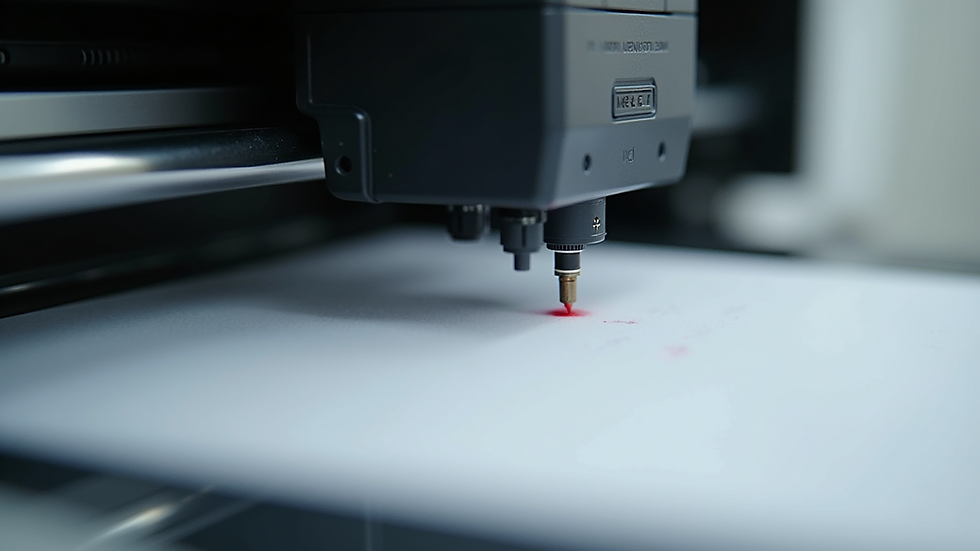Modern Techniques Revolutionizing Digital Printing
- cmyk graphics
- Sep 10
- 4 min read
Digital printing has transformed the way businesses and individuals produce high-quality prints quickly and efficiently. Over the years, advancements in technology have introduced modern techniques that are revolutionizing this industry. These innovations not only improve print quality but also reduce costs and environmental impact. This article explores the latest trends and technologies shaping the future of digital printing.
Advancements in Digital Printing Technology
Digital printing technology has evolved significantly from its early days. Today, it offers unparalleled precision and versatility. One of the key advancements is the use of high-resolution inkjet and laser printers that deliver sharp images and vibrant colors. These printers can handle a wide range of materials, including paper, fabric, plastic, and metal.
Another breakthrough is the integration of automation and AI-driven software. These systems optimize print layouts, color management, and workflow, reducing human error and increasing productivity. For example, automated color calibration ensures consistent color output across different print jobs, which is crucial for brand identity.
Additionally, UV printing technology has gained popularity. It uses ultraviolet light to cure inks instantly, allowing printing on non-porous surfaces like glass and ceramics. This method produces durable prints with excellent color fidelity and resistance to fading.

Benefits of Digital Printing in Modern Applications
Digital printing offers several advantages over traditional printing methods such as offset printing. One major benefit is the ability to print short runs economically. This flexibility is ideal for customized marketing materials, personalized gifts, and prototype packaging.
Moreover, digital printing supports variable data printing (VDP), which allows each printed piece to be unique. This is widely used in direct mail campaigns where personalized messages or images increase customer engagement.
Environmental sustainability is another important aspect. Modern digital printers use eco-friendly inks and generate less waste compared to conventional methods. The reduction in setup time and materials also contributes to a smaller carbon footprint.
Businesses looking for professional digital printing services can leverage these benefits to enhance their branding and customer experience. For instance, customized brochures, banners, and promotional items can be produced quickly without compromising quality.

How much does 1 page printing cost?
Understanding the cost of printing a single page is essential for budgeting and planning. The price depends on several factors including the type of printer, ink or toner used, paper quality, and print complexity.
For example, black and white laser printing typically costs less per page than color inkjet printing. On average, a black and white page may cost between ₹1 to ₹3, while a color page can range from ₹5 to ₹15 depending on the quality and size.
Bulk printing orders often reduce the cost per page due to economies of scale. Additionally, using professional digital printing services can provide competitive pricing and superior quality, especially for business needs.
To get an accurate estimate, consider the following:
Type of print (color or monochrome)
Paper size and type (glossy, matte, cardstock)
Print resolution and detail
Volume of pages to be printed
By evaluating these factors, you can choose the most cost-effective option without sacrificing quality.

Emerging Trends in Digital Printing Materials
The choice of materials used in digital printing has expanded dramatically. Modern printers can now handle a variety of substrates that were previously difficult or impossible to print on.
One exciting trend is the use of textile printing for fashion and interior design. Digital textile printing allows for intricate patterns and vibrant colors on fabrics like cotton, silk, and polyester. This technique supports fast turnaround times and small batch production, making it ideal for custom apparel and home décor.
Another innovation is 3D printing combined with digital printing. This hybrid approach enables the creation of textured and multi-dimensional prints, opening new possibilities in packaging and product design.
Additionally, eco-conscious materials such as recycled paper and biodegradable films are becoming more common. These materials align with the growing demand for sustainable printing solutions.
Practical Tips for Choosing the Right Digital Printing Technique
Selecting the appropriate digital printing technique depends on your specific project requirements. Here are some practical tips to guide your decision:
Define your print purpose - Are you printing marketing materials, packaging, or textiles? Different applications require different technologies.
Consider print volume - For small runs, digital printing is cost-effective. For large volumes, offset printing might be more economical.
Evaluate material compatibility - Ensure the printer supports the substrate you want to use.
Check color accuracy needs - For brand-critical colors, choose printers with advanced color management.
Assess turnaround time - Digital printing offers faster production, which is crucial for tight deadlines.
Factor in budget constraints - Balance quality and cost by comparing quotes from multiple providers.
By following these guidelines, you can maximize the benefits of modern digital printing techniques.
The Future of Digital Printing
The future of digital printing looks promising with continuous innovations on the horizon. Technologies like nanographic printing and artificial intelligence are expected to further enhance print quality and efficiency.
Moreover, the integration of Internet of Things (IoT) devices in printing equipment will enable real-time monitoring and predictive maintenance, reducing downtime and costs.
Sustainability will remain a key focus, with ongoing development of eco-friendly inks, substrates, and energy-efficient printers.
Businesses and individuals who embrace these modern techniques will enjoy greater creative freedom, faster production, and improved environmental responsibility.
Exploring options for professional digital printing can help you stay ahead in this rapidly evolving industry.






Comments